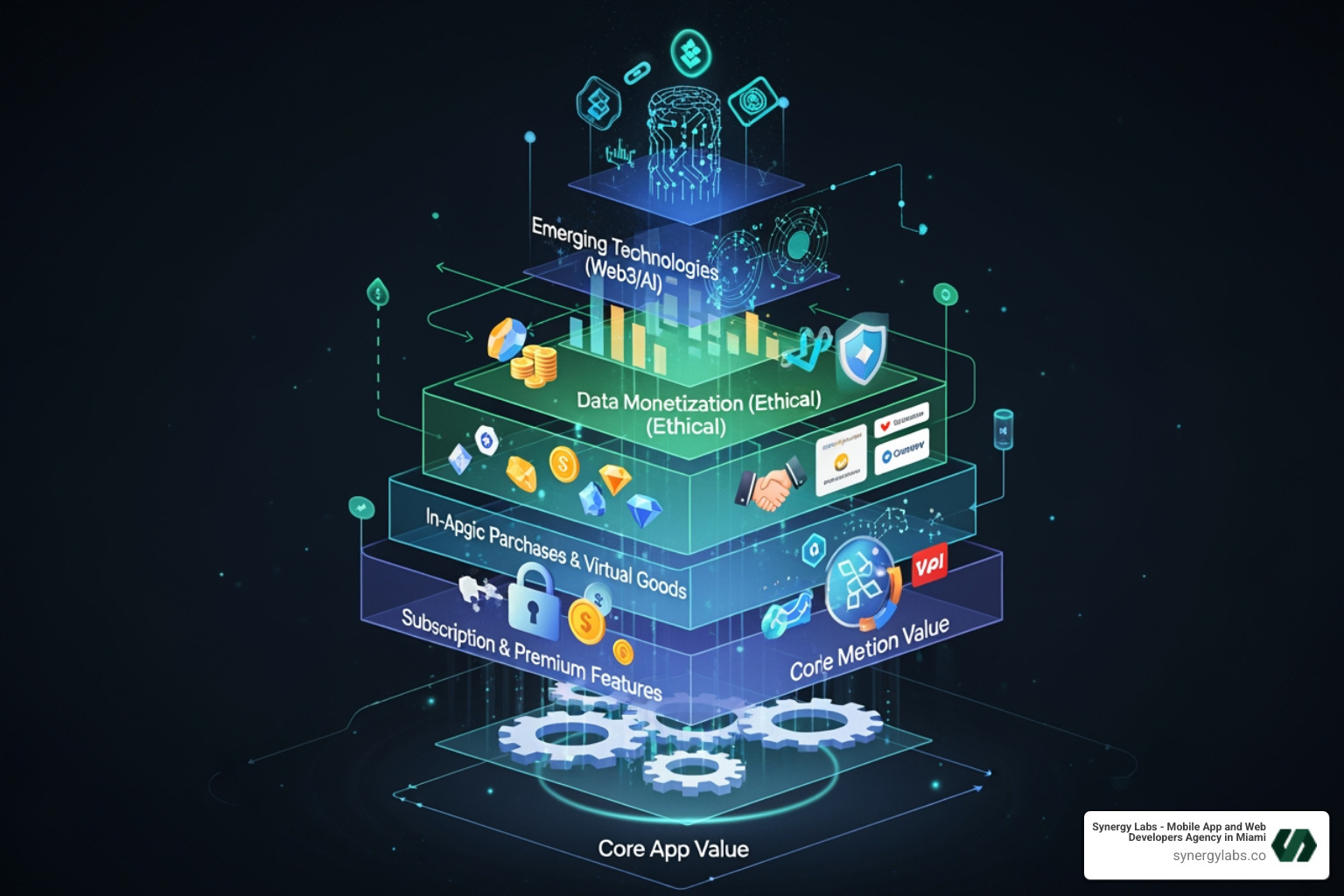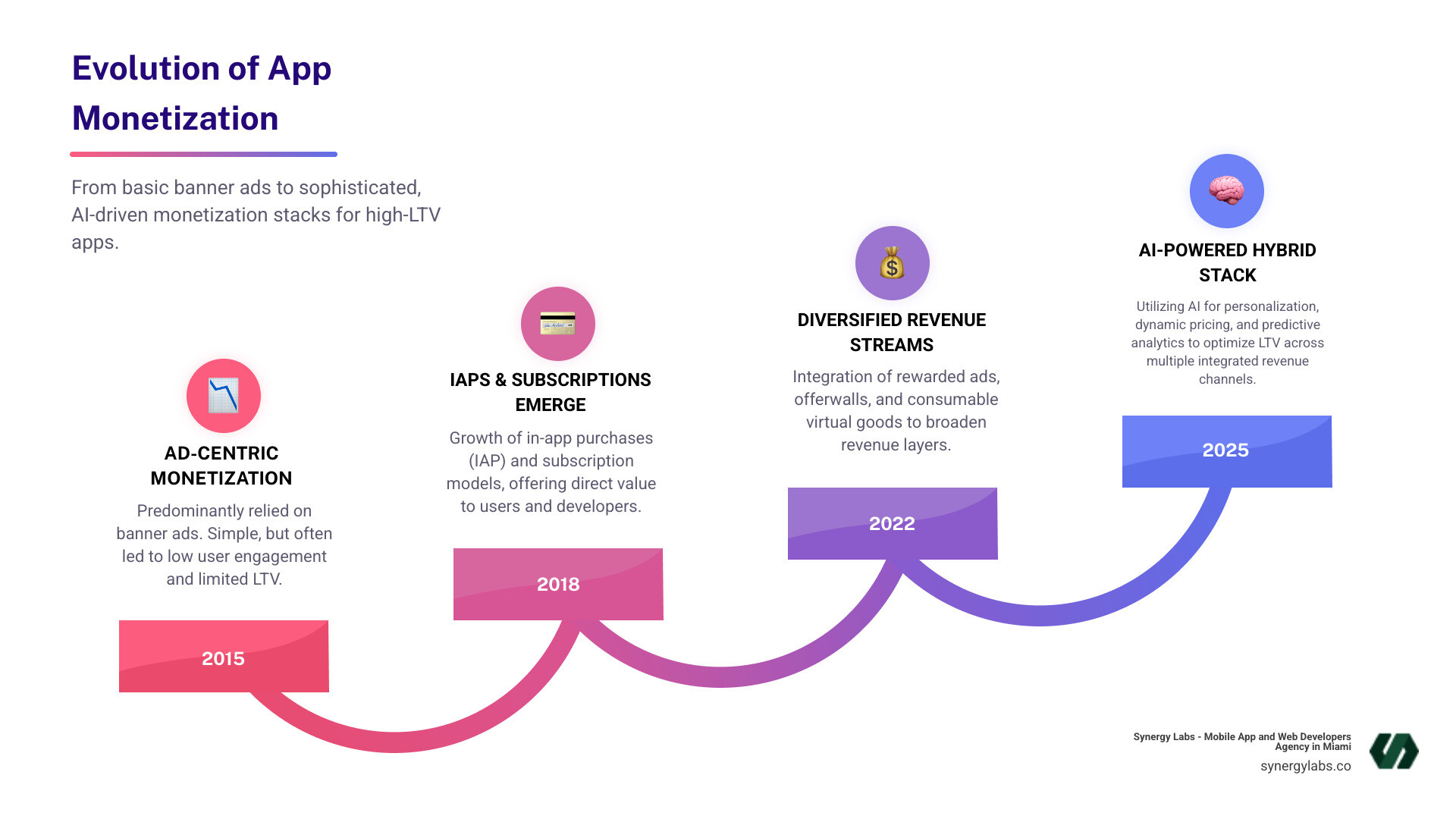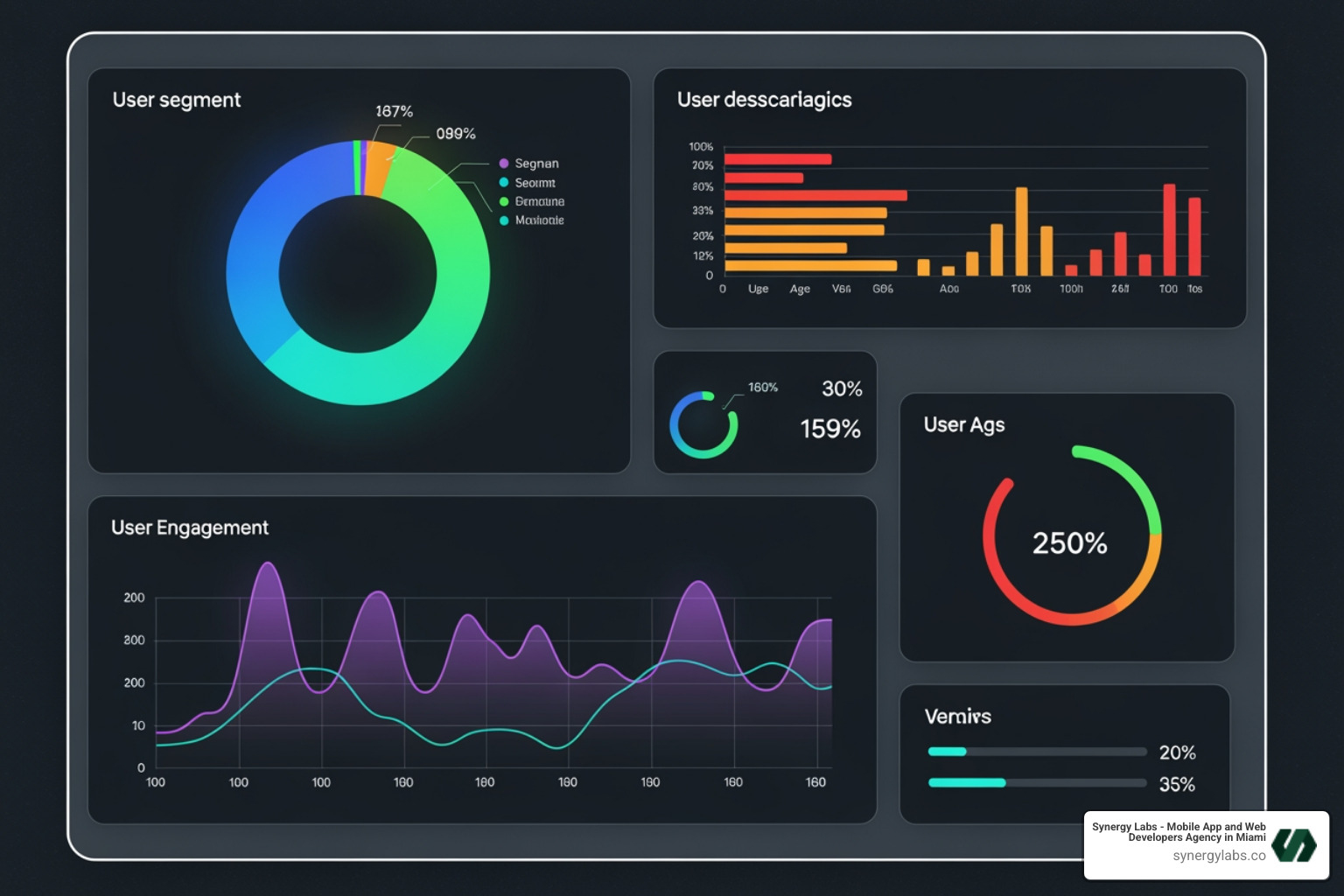S'associer à une agence de premier plan
Schedulea meeting via the form here and
we'll connect you directly with our director of product-no sales involved.
Prefer to talk now ?
Give us call at + 1 (645) 444 - 1069
"This is no longer optional. The key to building a sustainable business. The old playbook of relying on banner ads or one-time purchases is dead. Today's winning apps treat monetization as a core feature, not an afterthought."

In the competitive app market, Beyond Ads: The 2025 Monetization Stack for High-LTV Apps is no longer optional. The key to building a sustainable business. The old playbook of relying on banner ads or one-time purchases is dead. Today's winning apps treat monetization as a core feature, not an afterthought.
The modern monetization stack includes:
Key Insight: Apps using hybrid monetization models see a 30% increase in user lifetime value (LTV) compared to single-strategy apps.
While the mobile app economy is projected to hit $613 billion by 2025, over 95% of apps struggle with revenue. The winners build sophisticated monetization engines that balance user experience with multiple income streams. This shift was driven by privacy regulations, changing user expectations, and skyrocketing acquisition costs. At Synergy Labs, we help startups master this challenge by building apps that attract, engage, and retain paying users through data-driven strategies.

Further reading:
The app monetization landscape has evolved from clunky banner ads and simple paid downloads to a sophisticated ecosystem built around diversified revenue.
The journey began with $0.99 upfront payments, which quickly gave way to the rise of In-App Purchases (IAP) and the freemium model. The subscription economy then introduced predictable, recurring revenue. However, the biggest disruption came from the privacy-first era. Apple's App Tracking Transparency (ATT) broke old attribution models, forcing developers to master SKAdNetwork and steer regulations like the EU Digital Markets Act (DMA). This 2025 strategic shift is not about choosing one method, but orchestrating multiple streams into a cohesive experience.
The old single-stream approach was unsustainable. Apps relying solely on banner ads suffered from poor user experience and high churn. The one-time paid download model also faded, as users now expect to try before they buy. Today, less than 5% of apps are paid upfront. These older models lacked personalization and treated all users the same, leading to missed revenue opportunities, low LTV, and models that couldn't survive in a competitive market.
Welcome to 2025, where the winning strategy is all about diversification and user-centricity. Successful apps build sophisticated hybrid models that give every user a way to contribute.

This user-centric approach relies on data-driven decisions to deliver personalized experiences. It's about offering a value exchange, like a rewarded video ad for in-game currency, rather than an interruption. This way, non-paying users can contribute through ad engagement, while power users access premium features via subscriptions or in-app purchases (IAP).
The data is clear: apps using hybrid models see a 30% increase in user lifetime value (LTV). An improved user experience (UX), where monetization feels like a feature, leads to higher retention and revenue. In short, thoughtfully layered revenue streams create a symbiotic relationship where both the user and developer benefit.
Your monetization stack is the heart of your app's business model, custom-built for your audience. Success comes from balancing four critical elements: hybrid monetization, subscriptions, emerging revenue streams, and analytics. The core idea is that since your users aren't all the same, you shouldn't monetize them the same way.

Since only about 1.83% of mobile game players spend on in-app purchases, relying solely on IAP means ignoring 98% of your users. Hybrid monetization, which combines in-app advertising (IAA) with in-app purchases (IAP), creates multiple revenue pathways.
Rewarded video ads are a key component, offering a value exchange (e.g., watch an ad for virtual currency) that users prefer. Interstitials and offerwalls can supplement revenue when used thoughtfully between levels or tasks. Other elements include consumables (extra lives), cosmetics (character skins), and the classic "remove ads" purchase option. This hybrid approach gives users choices and significantly boosts revenue and ROAS, as shown by studies on hybrid monetization.
Subscriptions provide stability and predictable revenue, essential for apps delivering ongoing value. The freemium model is the standard playbook: offer enough free value to hook users, then present a clear upgrade path. Many category leaders convert a large portion of their free users into paying subscribers.
Free trials are powerful conversion tools, as they let users experience the full value before paying. Data shows trials deliver 2-3x more paid users than a direct paywall. While some churn is inevitable, longer trials can improve conversion. Other strategies include tiered pricing to capture different user segments and optimizing your paywall design and onboarding flow. The global subscription economy is projected to hit nearly $1.26 trillion by 2025, highlighting this fundamental shift.
The most innovative apps are exploring new territories that truly push monetization forward.
Gamification elements like streaks and challenges can boost engagement and conversions in any app. Augmented Reality (AR) ads offer interactive experiences like virtual try-ons, which generate higher engagement and conversion intent, according to industry data. In-app events and LiveOps campaigns create urgency and drive IAP spikes, especially in gaming. Finally, web2app funnels and direct-to-consumer payments, enabled by regulatory changes, allow users to subscribe or purchase on the web, reducing friction and opening new revenue channels.
In 2025, building an app without a robust analytics layer is like flying blind. Data is the foundation for every decision. It tells you who your users are, what they want, and how to keep them engaged and paying.
The analytics ecosystem includes product analytics to understand in-app behavior and growth analytics to connect that behavior to acquisition efforts. At the heart of this is user segmentation, which allows you to divide users into groups (e.g., high spenders vs. non-spenders) and tailor monetization accordingly. LTV and churn prediction models use historical data to forecast future behavior, enabling proactive retention efforts. Finally, A/B testing monetization models is crucial for validating assumptions with real data, allowing you to optimize everything from paywall designs to ad placements.

AI and Machine Learning are no longer futuristic concepts; they are practical tools for personalizing the monetization journey for every user. As noted in reports on AI personalization, this approach significantly boosts revenue.
You can't improve what you don't measure. To evaluate a modern monetization strategy, track the right metrics.
Building a future-proof monetization stack requires a custom approach. What works for a hyper-casual game (rewarded ads, light IAP) won't work for a productivity app (subscriptions). The key is matching your monetization strategy to your app's genre, user behavior, and core value proposition.
A critical challenge is balancing user experience with monetization. Showing too many ads drives users away, while a premature paywall can kill adoption. The goal is to make monetization feel like a natural extension of the app's value, not an interruption. Privacy compliance is another non-negotiable. Regulations like GDPR and CCPA demand transparency and respect for user data, which is essential for building trust. While focusing on core markets, don't overlook global opportunities.

With only a tiny fraction of users making in-app purchases, a hybrid model combining In-App Advertising (IAA) and In-App Purchases (IAP) is essential.
The key is segmentation. For non-spenders, lean into rewarded ads that offer a clear value exchange. For spenders, reduce ad exposure and offer an IAP option to remove ads entirely. This classic hybrid strategy improves their experience and converts ad-monetized users into paying customers. There's no magic IAA-to-IAP revenue ratio; the goal is to integrate both intelligently so every user contributes to your bottom line. For more on crafting effective strategies, check out our resources on mobile app strategy.
Privacy has reshaped app monetization. Apple's App Tracking Transparency (ATT), GDPR, and the EU's Digital Markets Act (DMA) have made privacy the new normal. This is both a challenge and an opportunity.
Adapting requires using privacy-preserving attribution tools like Apple's SKAdNetwork 5 and AdAttributionKit. Consent Management Platforms (CMPs) are now essential for managing user consent and ensuring compliance. The focus has shifted to first-party data, which is data you collect directly from your users with their permission. This allows for personalization without relying on restricted third-party data. Contextual advertising—targeting ads based on in-app context rather than user data—is also making a comeback. Building user trust through transparency is the foundation for long-term success in a privacy-first world.
Implementing a modern monetization stack raises many questions. Here are answers to the most common ones we hear at Synergy Labs.
There is no single "ideal" ratio. It depends entirely on your app's genre and user base. The best strategy is to segment your users. High-spenders might see fewer ads or get an option to remove them via IAP. Meanwhile, the majority of non-spending users can be monetized effectively through rewarded ad formats. The goal is to create a personalized balance for each user type, not to chase a specific number.
The key is to start small and prioritize value. Begin by introducing opt-in, value-driven ad formats like rewarded videos, which give users something tangible in return for their attention. Users don't hate ads; they hate ads that provide no benefit. A/B test any new monetization feature with a small segment of your audience first. Monitor engagement and retention before rolling it out to everyone to ensure a positive reception.
Absolutely. The tools and infrastructure for building a sophisticated stack have become remarkably accessible. Analytics platforms, attribution tools, and monetization SDKs now offer generous free tiers or affordable pricing. The key is to start with a solid foundation—like a simple hybrid of IAP and rewarded ads—and iterate. Master the basics, understand your user data, and then layer in more advanced elements over time. A sophisticated stack is built through continuous testing and refinement.
The days of relying on a single revenue stream are over. The modern monetization stack is a diversified, personalized, and data-driven engine for growth. The difference between a struggling app and a sustainable business lies in the sophistication of the monetization strategy woven into its core.
This approach—combining hybrid IAA/IAP, subscriptions, emerging streams like AR, and AI-powered personalization—is the playbook for the top 5% of apps. It's about understanding users so deeply that you can offer value in the exact form they want it.
Building this infrastructure is complex. It requires a technical foundation and a team that understands how features connect to retention, engagement, and revenue. At Synergy Labs, we don't just build apps—we build revenue engines. We integrate monetization strategy from the first wireframe to optimize for both user satisfaction and long-term LTV.
Ready to stop leaving money on the table and start building an app that maximizes lifetime value? Explore our services to start building your high-LTV app today. Let's turn your app idea into a thriving, profitable reality.

Pour commencer, rien de plus simple ! Il vous suffit de nous contacter en nous faisant part de votre idée à l'aide de notre formulaire de contact. L'un des membres de notre équipe vous répondra dans un délai d'un jour ouvrable par courriel ou par téléphone pour discuter de votre projet en détail. Nous sommes impatients de vous aider à concrétiser votre vision !
Choisir SynergyLabs, c'est s'associer à une agence de développement d'applications mobiles de premier plan qui donne la priorité à vos besoins. Notre équipe, entièrement basée aux États-Unis, se consacre à la livraison d'applications de haute qualité, évolutives et multiplateformes, rapidement et à un prix abordable. Nous mettons l'accent sur un service personnalisé, en veillant à ce que vous travailliez directement avec des talents chevronnés tout au long de votre projet. Notre engagement envers l'innovation, la satisfaction du client et la communication transparente nous distingue des autres agences. Avec SynergyLabs, vous pouvez être sûr que votre vision sera concrétisée avec expertise et soin.
Nous lançons généralement les applications dans un délai de 6 à 8 semaines, en fonction de la complexité et des fonctionnalités de votre projet. Notre processus de développement rationalisé vous permet de commercialiser rapidement votre application tout en bénéficiant d'un produit de haute qualité.
Notre méthode de développement multiplateforme nous permet de créer simultanément des applications web et mobiles. Cela signifie que votre application mobile sera disponible à la fois sur iOS et Android, assurant une large portée et une expérience utilisateur transparente sur tous les appareils. Notre approche vous permet d'économiser du temps et des ressources tout en maximisant le potentiel de votre application.
Chez SynergyLabs, nous utilisons une variété de langages de programmation et de frameworks pour répondre au mieux aux besoins de votre projet. Pour le développement multiplateforme, nous utilisons Flutter ou Flutterflow, ce qui nous permet de prendre en charge efficacement le web, Android et iOS avec une seule base de code - idéal pour les projets avec des budgets serrés. Pour les applications natives, nous utilisons Swift pour iOS et Kotlin pour les applications Android.




Pour les applications web, nous combinons des frameworks de mise en page frontale comme Ant Design, ou Material Design avec React. Pour le backend, nous utilisons généralement Laravel ou Yii2 pour les projets monolithiques, et Node.js pour les architectures sans serveur.






En outre, nous pouvons prendre en charge diverses technologies, notamment Microsoft Azure, Google Cloud, Firebase, Amazon Web Services (AWS), React Native, Docker, NGINX, Apache, et bien plus encore. Cet ensemble de compétences diversifiées nous permet de fournir des solutions robustes et évolutives adaptées à vos besoins spécifiques.








La sécurité est une priorité absolue pour nous. Nous mettons en œuvre des mesures de sécurité conformes aux normes de l'industrie, notamment le cryptage des données, des pratiques de codage sécurisées et des audits de sécurité réguliers, afin de protéger votre application et les données de vos utilisateurs.
Oui, nous offrons une assistance, une maintenance et des mises à jour continues pour votre application. Après l'achèvement de votre projet, vous recevrez jusqu'à 4 semaines de maintenance gratuite pour vous assurer que tout se passe bien. Après cette période, nous vous proposons des options d'assistance continue flexibles adaptées à vos besoins, afin que vous puissiez vous concentrer sur le développement de votre activité pendant que nous nous occupons de la maintenance et des mises à jour de votre application.